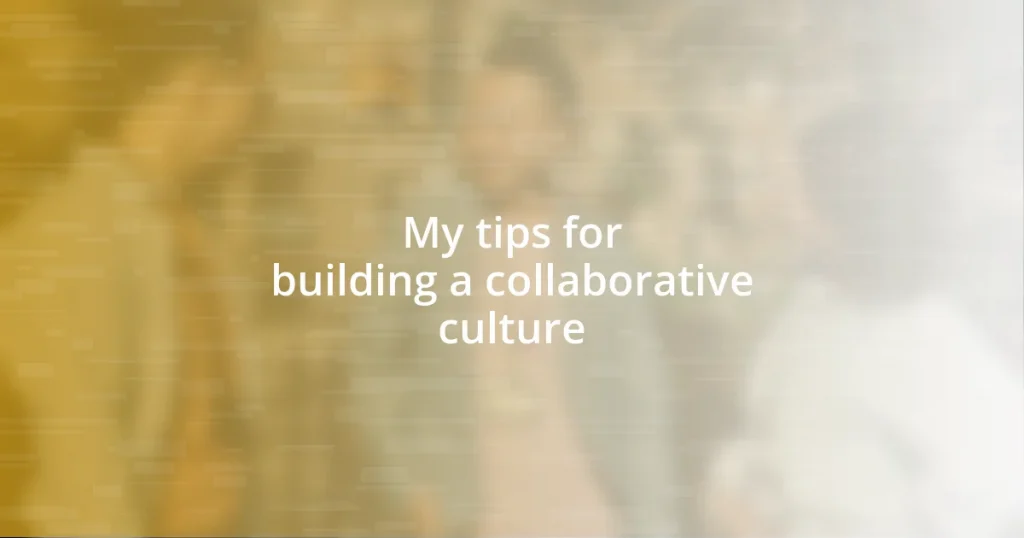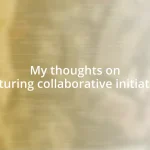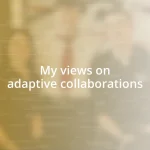Key takeaways:
- Collaboration enhances innovation and creates a sense of belonging, driving both project success and team relationships.
- Assessing the current culture through surveys and observations helps identify strengths and weaknesses, paving the way for effective collaboration strategies.
- Recognizing and rewarding teamwork fosters motivation and strengthens a collaborative culture, transforming group efforts into committed collaborations.
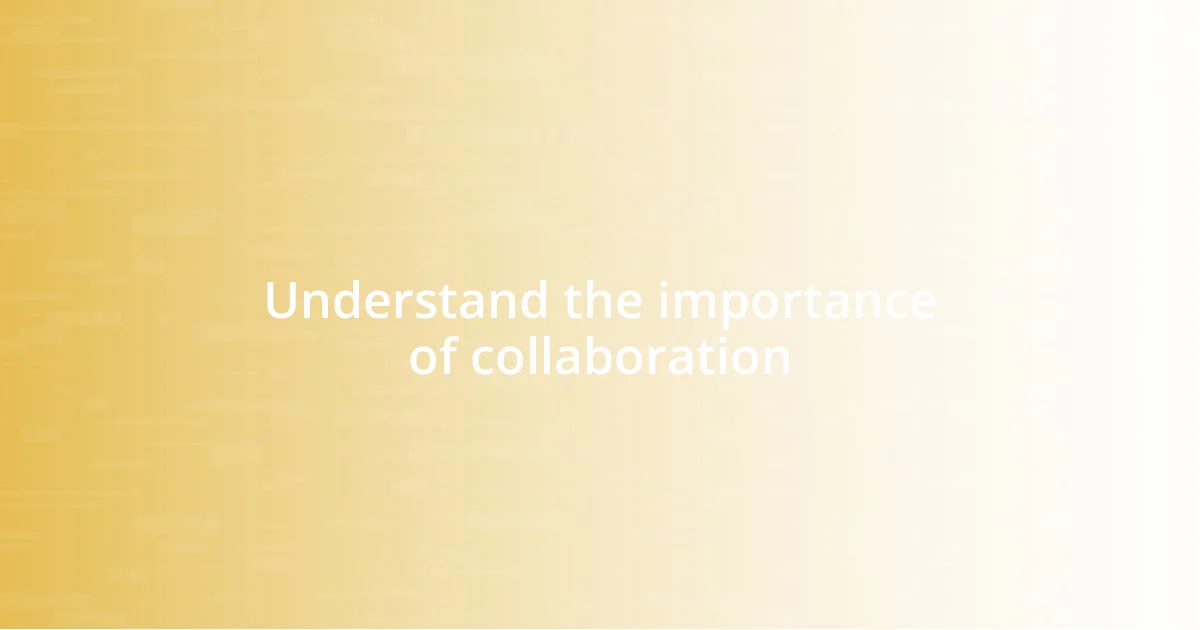
Understand the importance of collaboration
Collaboration is a real game-changer. I remember working on a project where team members brought their unique skills to the table, and that diversity led to creative solutions I never would have thought of alone. It’s incredible how combining different perspectives can spark innovation and drive results that truly resonate.
When I think about collaboration, it reminds me of a time when we faced a tight deadline. The power of teamwork shone through as we discussed ideas, shared responsibilities, and motivated each other. Have you experienced that rush when a team comes together to tackle a challenge? I find that those moments not only foster strong relationships but also create a sense of belonging and shared purpose.
Moreover, collaboration isn’t just about achieving goals; it’s about building a culture where everyone feels valued and heard. When individuals contribute and see their ideas take shape, it creates an emotional investment in the work. Isn’t it remarkable how collaboration can transform not just projects but also people? Each successful collaboration has the potential to elevate both the team’s spirit and the organization’s atmosphere.
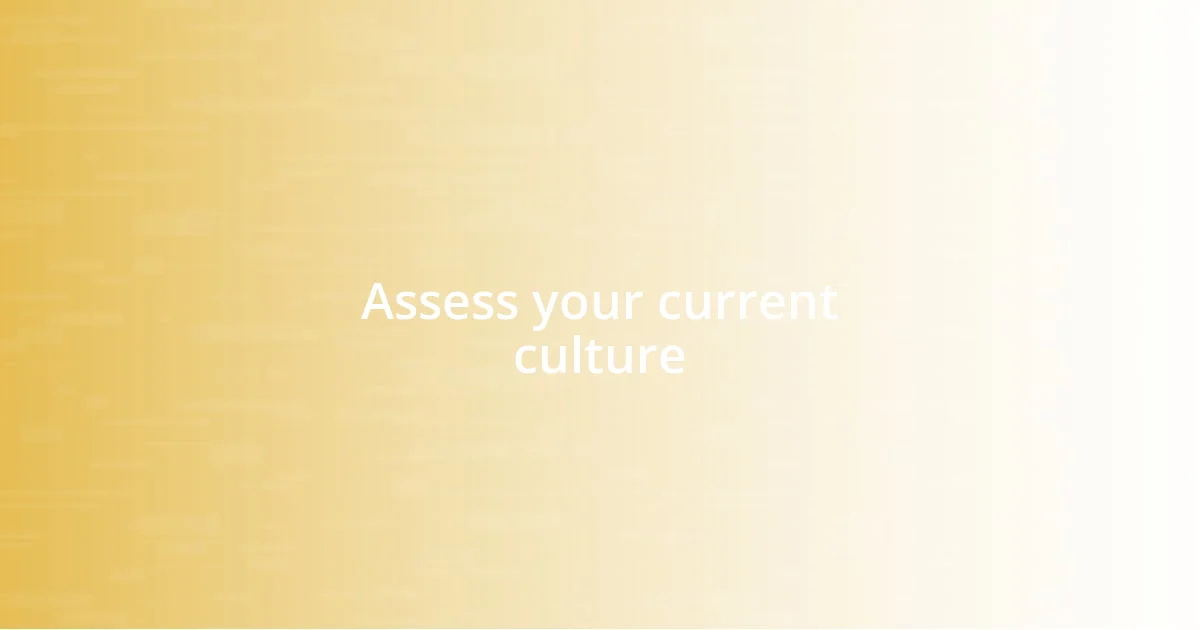
Assess your current culture
To truly understand where you want to go in building a collaborative culture, you first need to take a good look at where you currently stand. I recall doing a culture assessment at my previous job, which revealed that people felt siloed rather than part of a cohesive team. Reflecting on this, I realized how essential it is to gather input from all levels of the organization. Have you ever conducted a survey or informal chat to gauge your team’s thoughts on collaboration? It can be eye-opening.
A culture assessment isn’t just about identifying problems; it’s also about recognizing strengths. In one instance, my team discovered that while communication had room for improvement, our ability to provide constructive feedback was stronger than we had thought. It was enlightening to see that what we perceived as a weakness could actually serve as a foundation for enhancing collaboration. I encourage you to celebrate these strengths even as you work on the challenges.
Lastly, don’t underestimate the power of observation. I often walked through the office to get a feel for the interactions happening in the space. By paying attention to how teams interacted and approached challenges together, I gathered insights that surveys alone couldn’t provide. What informal observations can you make that might reveal the state of your culture? Those nuanced insights can lead to a more honest and productive conversation about building a truly collaborative environment.
| Assessment Aspect | Insights Gained |
|---|---|
| Surveys | Gather anonymous feedback on collaboration experiences. |
| Strengths Recognition | Identify and leverage existing collaborative practices. |
| Observation | Observe real-time interactions to uncover true dynamics. |
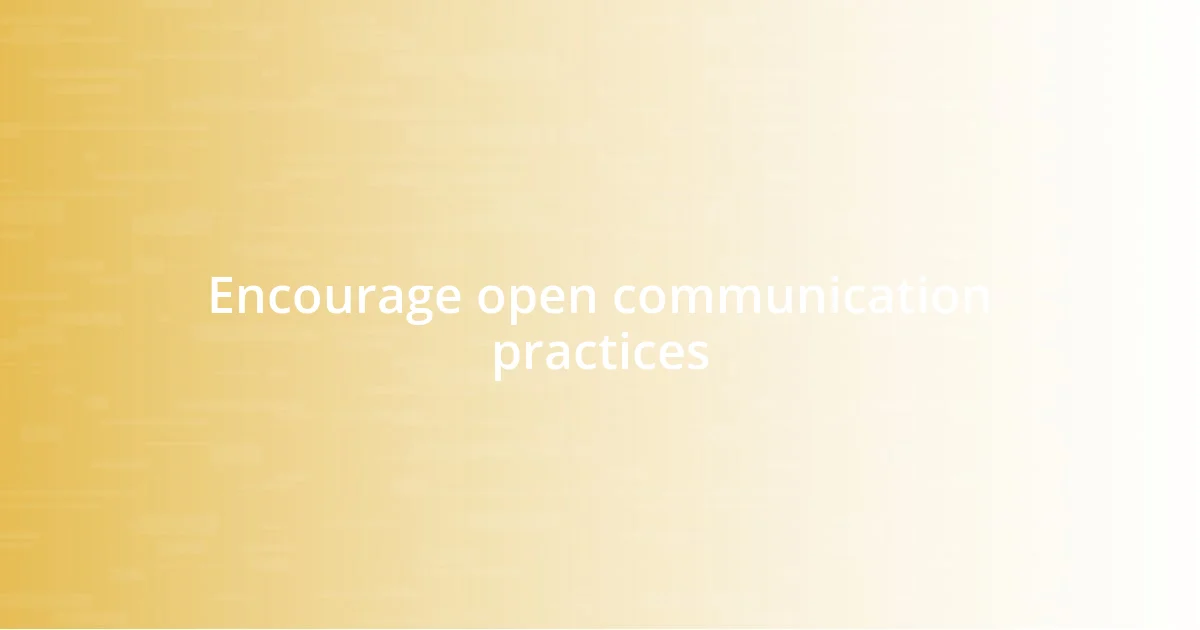
Encourage open communication practices
One of the most rewarding experiences I’ve had while building a collaborative culture was witnessing the shift in our communication styles. Initially, I noticed that team members were hesitant to share their thoughts openly, often waiting for the “right” moment. To change this, I encouraged regular check-ins and informal brainstorming sessions. It was amazing to see how quickly the atmosphere lightened as people realized their voices mattered. Those small gatherings sparked lively discussions and allowed everyone to contribute without the pressure of formal agendas.
- Implement regular team check-ins to encourage the sharing of ideas.
- Establish open-door policies where team members can express concerns without fear.
- Promote transparency by sharing successes and failures openly within the team.
Creating an environment where open communication thrives isn’t just about systems; it’s about nurturing trust and vulnerability. I remember a time when a colleague shared a personal story about a challenge they faced, and it inspired the rest of us to open up about our own struggles. This exchange fostered stronger bonds among the team, demonstrating that honesty can be a powerful catalyst for collaboration. When team members feel safe to express themselves, it leads to richer discussions and, ultimately, better outcomes.
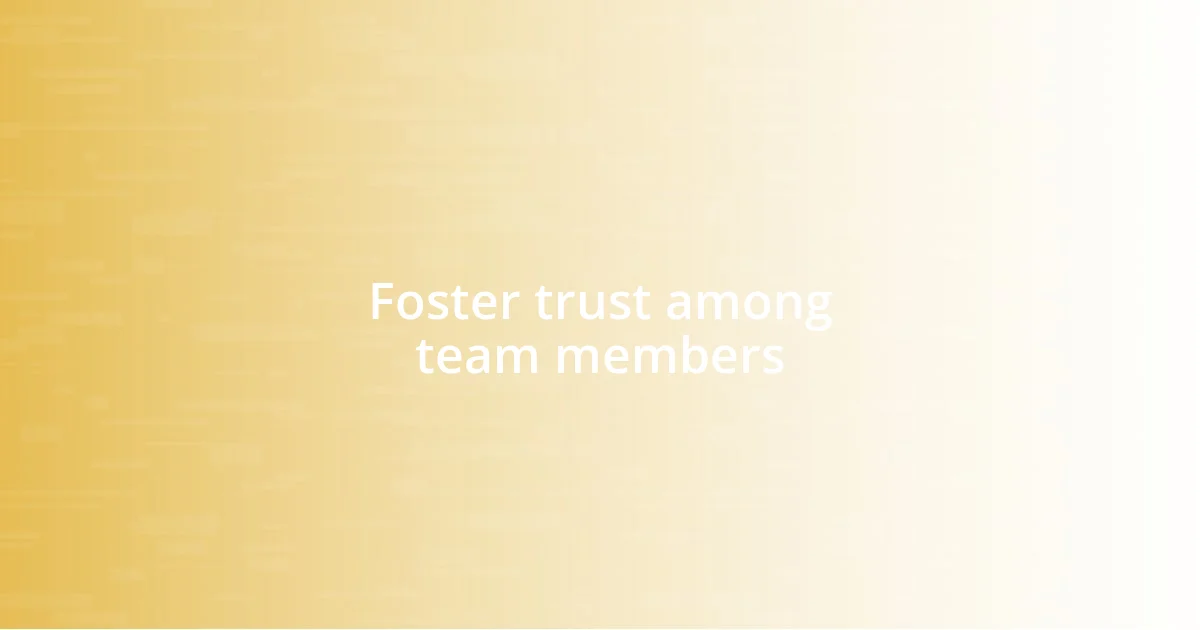
Foster trust among team members
Trust is the foundation that holds a collaborative team together. I vividly remember a project where tight deadlines amplified stress. During one particularly exhaustive week, a teammate admitted she was overwhelmed. Instead of brushing it off, we took a few minutes to discuss our challenges openly. It shifted our focus from individual stress to collective support, fostering an atmosphere of trust and accountability. Have you ever taken a moment to voice vulnerabilities? It can create a powerful shift in dynamics.
Creating opportunities for team members to build trust can transform the tone of collaboration. I found that team-building exercises, like sharing personal anecdotes during lunch breaks, helped us see each other as more than just colleagues. One day, I shared a story about my early career struggles, which led others to open up about their own experiences. This vulnerability deepened our connections, making it easier for us to lean on one another during tougher times. When was the last time you shared something personal with your team? Those moments can break down barriers.
However, it’s important to acknowledge that trust takes time and consistency to build. I learned this the hard way when I initiated a team retreat focused solely on bonding without establishing an environment of trust first. Initially, some team members were skeptical, and it took several honest conversations to ease their apprehension. Over time, as we built trust through transparency and shared experiences, I saw a noticeable shift in collaboration. Are you willing to invest the time needed to nurture trust within your team? The results can be truly rewarding.
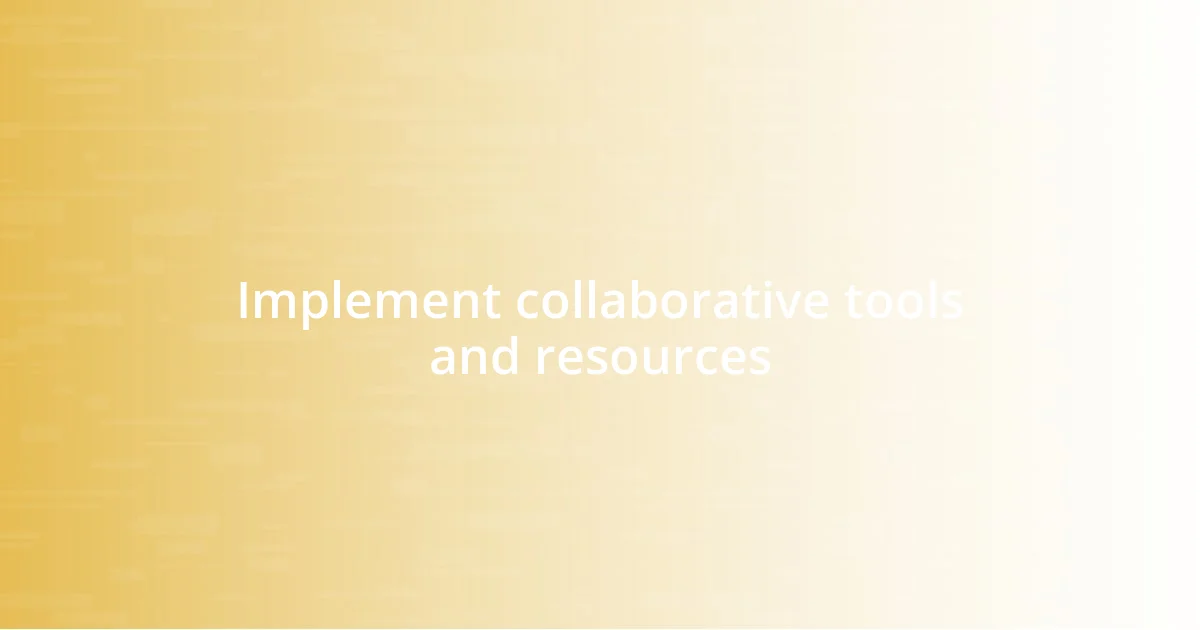
Implement collaborative tools and resources
Implementing collaborative tools can remarkably enhance team dynamics. I once introduced a project management software that transformed how we worked together. At first, there was some resistance—change is often met with skepticism. However, once everyone got the hang of the features and benefits, it created such clarity around tasks that team members felt empowered to contribute more actively. How often have you found a tool that made your workflow smoother? It’s a game-changer.
Resources like shared digital whiteboards and communication platforms can significantly boost creativity and collaboration. I vividly remember a brainstorming session we had using a digital whiteboard tool; it felt as though our ideas could visually flourish in real time. The energy in the virtual room was palpable as ideas bounced back and forth. It dawned on me that the right tools not only aid in organization but also inspire creativity. Have you considered how the tools you’re currently using may be holding your team back?
As I explored various collaborative resources, I discovered the impact of integrating feedback tools that allowed for anonymous suggestions. This approach helped encourage honesty while ensuring everyone felt safe to share their thoughts. One time, an unexpected gem emerged from an anonymous submission that completely reshaped our project direction! Reflecting on that, I realized how vital it is to create avenues for unfiltered communication. What’s stopping your team from reaching out with innovative ideas? Sometimes, it just takes the right platform to unlock potential.
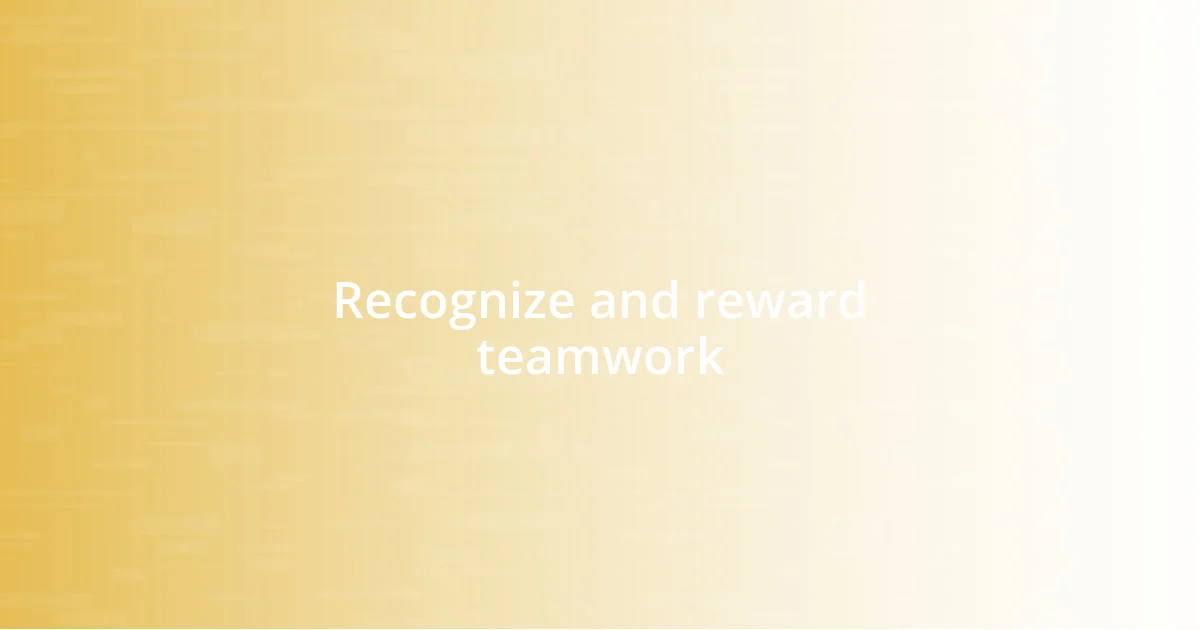
Recognize and reward teamwork
Recognizing and rewarding teamwork can significantly bolster a collaborative culture. I recall a time when our manager surprised us with a small award for our collective efforts on a challenging project. It wasn’t just about the recognition; it was the way it made us feel valued as a cohesive unit. Have you ever experienced a moment where appreciation from others sparked a renewed passion within you? It can be incredibly motivating.
Simple gestures can go a long way in acknowledging team spirit. One year, I started a “Team Player of the Month” feature during our meetings, where we would highlight one individual who exemplified collaboration. Not only did it shine a light on personal contributions, but it also inspired others to step up and embrace teamwork wholeheartedly. How has recognition influenced your motivation or performance in a group setting? Personal acknowledgment fosters a cycle of support and encouragement.
Deliberate and thoughtful recognition can transform mere teamwork into committed collaboration. I remember a period where we faced rough patches, and our manager began allocating time during our one-on-ones to celebrate wins—big and small. This simple adjustment shifted our mindset; instead of fixating on failures, we learned to share successes, no matter how minor they seemed. Have you evaluated how often you celebrate achievements within your own team? It might just unearth a treasure trove of collective pride in your team culture.










